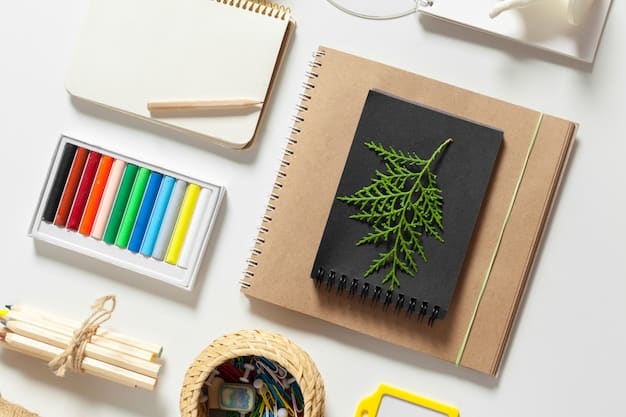Creating Your Self-Care Toolkit: Resources for Emotional Support

Creating a self-care toolkit involves assembling personalized resources and strategies to manage stress, promote emotional well-being, and build resilience for navigating life’s challenges effectively.
In today’s fast-paced world, prioritizing mental and emotional well-being is more crucial than ever. Creating a self-care toolkit: assembling resources for emotional support can provide you with personalized strategies and resources to manage stress, enhance resilience, and foster overall well-being.
Understanding the Importance of a Self-Care Toolkit
A self-care toolkit is a collection of resources and activities that you can draw upon to support your mental and emotional health. It’s about being proactive in addressing your needs and building resilience against stress and challenges. By intentionally curating a toolkit, you’re creating a personalized strategy for maintaining and improving your well-being.
Having a well-stocked self-care toolkit can make a profound difference in your ability to manage stress, regulate emotions, and bounce back from setbacks. It provides a tangible reminder of your commitment to your well-being and offers a sense of control during difficult times.

Why Self-Care is Essential
Self-care is not selfish; it’s essential for maintaining your overall health and well-being. When you prioritize self-care, you’re better equipped to handle stress, maintain healthy relationships, and perform at your best in all areas of your life. Neglecting self-care can lead to burnout, increased stress levels, and a decline in both mental and physical health.
Benefits of a Personalized Toolkit
A personalized self-care toolkit ensures that the strategies and resources you use are tailored to your unique needs and preferences. What works for one person may not work for another, so it’s important to experiment and find what resonates with you. A personalized toolkit also empowers you to take ownership of your well-being and make conscious choices that support your mental and emotional health.
- Improved Stress Management: Provides tools to cope with daily stressors effectively.
- Enhanced Emotional Regulation: Helps manage and regulate emotions in a healthy way.
- Increased Resilience: Builds the ability to bounce back from setbacks and challenges.
- Better Overall Well-being: Contributes to improved mental and physical health.
Ultimately, understanding the importance of a self-care toolkit and its benefits is the first step towards prioritizing your mental and emotional health. By building a personalized toolkit, you’re investing in your well-being and creating a foundation for a happier, healthier, and more resilient life.
Identifying Your Needs and Preferences
Before you start assembling your self-care toolkit, it’s important to identify your specific needs and preferences. Reflecting on what brings you joy, helps you relax, and supports your emotional well-being will guide you in selecting the most effective strategies and resources. Understanding your unique needs ensures that your toolkit is tailored to your individual requirements.
Take some time to consider what activities, practices, or resources have been helpful to you in the past. Reflect on what makes you feel grounded, centered, and calm. Think about what you need during times of stress, anxiety, or sadness. This self-assessment will help you create a toolkit that is truly personalized and effective.
Reflecting on Past Experiences
Consider past experiences where you successfully managed stress or improved your mood. What specific actions did you take? What resources did you use? Identifying these successful strategies can provide valuable insights into what works best for you. Also, reflect on situations where certain self-care practices were not effective, and consider why they didn’t work.
Understanding Your Triggers
Identifying your triggers—the people, places, situations, or thoughts that lead to negative emotions—is crucial for developing effective coping strategies. Once you know what your triggers are, you can proactively prepare and incorporate specific tools into your toolkit to manage them. This could involve relaxation techniques, cognitive restructuring, or setting boundaries.

- Journaling: Write down your thoughts and feelings to gain clarity and insight.
- Meditation: Practice mindfulness to calm your mind and reduce stress.
- Physical Activity: Engage in exercise to release endorphins and improve mood.
- Creative Expression: Explore activities like painting, drawing, or writing to express yourself.
Identifying your needs and preferences is an ongoing process. As you evolve and your circumstances change, your self-care toolkit should also adapt. Regularly reassess your needs and adjust your toolkit accordingly to ensure it remains relevant and effective.
Assembling Resources for Your Toolkit
Now that you have a better understanding of your needs and preferences, it’s time to start assembling the resources for your self-care toolkit. This involves gathering a variety of tools, activities, and resources that you can use to support your mental and emotional well-being. The goal is to create a diverse and accessible collection that you can easily turn to when you need it.
Consider including resources that cater to different aspects of your well-being, such as physical, emotional, social, and spiritual. This holistic approach ensures that you’re addressing all facets of your health. Think about adding items that are readily available and easy to incorporate into your daily routine.
Physical Well-being Resources
Physical self-care is essential for maintaining your overall health and energy levels. Incorporating resources that promote physical well-being into your toolkit can help you manage stress and improve your mood. This might include items such as exercise equipment, healthy snacks, or relaxation tools.
Include resources that cater to activities you enjoy. This could be anything from a yoga mat and resistance bands to a pedometer and a water bottle. The key is to select items that make it easier and more enjoyable for you to prioritize your physical health.
Emotional Well-being Resources
Emotional self-care involves practices that help you manage and regulate your emotions in a healthy way. Resources for emotional well-being might include journals, art supplies, or calming music. These tools can provide an outlet for emotional expression and help you cultivate a sense of inner peace.
- Journaling: A notebook and pen for writing down thoughts and feelings.
- Essential Oils: Aromatherapy oils like lavender or chamomile for relaxation.
- Affirmation Cards: Positive statements to boost self-esteem and confidence.
- Comfort Items: A soft blanket or a favorite stuffed animal for comfort.
Assembling resources for your self-care toolkit is a personalized process. The most important thing is to choose items that resonate with you and support your individual needs. Don’t be afraid to experiment and adjust your toolkit as you discover what works best.
Incorporating Mindfulness and Meditation
Mindfulness and meditation practices are powerful tools for reducing stress, improving focus, and enhancing emotional well-being. Incorporating these practices into your self-care toolkit can provide you with effective strategies for managing daily challenges and cultivating a sense of inner peace. Mindfulness involves paying attention to the present moment without judgment, while meditation is a technique for training your mind to focus and calm your thoughts.
Start by exploring different types of mindfulness and meditation practices to find what resonates with you. This could include guided meditations, breathing exercises, body scan meditations, or mindful walking. The key is to find a practice that you enjoy and can easily incorporate into your daily routine.
Guided Meditations
Guided meditations are a great way to get started with meditation, especially if you find it difficult to quiet your mind on your own. These meditations typically involve a narrator who guides you through visualizations, breathing exercises, and positive affirmations. You can find guided meditations on various apps, websites, and streaming platforms.
Breathing Exercises
Simple breathing exercises can be powerful tools for calming your mind and reducing stress. One popular technique is the 4-7-8 breathing exercise, which involves inhaling for four seconds, holding your breath for seven seconds, and exhaling for eight seconds. This exercise can help regulate your nervous system and promote relaxation.
- Apps: Headspace, Calm, Insight Timer
- Online Resources: YouTube, universities, and meditation centers
- Books: Mindfulness for Beginners, Wherever You Go, There You Are
- Workshops and Retreats: Local studios and wellness centers
Incorporating mindfulness and meditation into your self-care toolkit can significantly enhance your ability to manage stress, regulate emotions, and cultivate a greater sense of inner peace. By finding practices that resonate with you and making them a regular part of your routine, you can experience the profound benefits of these powerful tools.
Leveraging Social Support and Connection
Human beings are inherently social creatures, and strong social connections are essential for mental and emotional well-being. Leveraging social support and connection in your self-care toolkit can provide you with a sense of belonging, reduce feelings of isolation, and enhance your overall quality of life. Social support networks offer a safe space to share your thoughts and feelings, receive encouragement, and gain perspective during challenging times.
Start by identifying the people in your life who provide you with positive support and encouragement. These might be family members, friends, colleagues, or members of your community. Make a conscious effort to nurture these relationships and create opportunities for meaningful connection.
Building a Support Network
Building a strong support network involves fostering relationships with people who understand and support your needs. This might include joining social groups, volunteering in your community, or participating in activities that allow you to connect with others who share your interests. The goal is to create a network of people you can rely on for emotional support.
Setting Boundaries
While social support is important, it’s also essential to set healthy boundaries in your relationships. This involves communicating your needs and limits to others and being assertive in protecting your time and energy. Setting boundaries can help you maintain healthy relationships and prevent burnout.
- Schedule Regular Check-ins: Make time to connect with friends and family regularly.
- Join Support Groups: Find groups that align with your interests or needs.
- Seek Professional Help: Consider therapy or counseling for additional support.
- Practice Active Listening: Be present and attentive when others are sharing.
Leveraging social support and connection in your self-care toolkit can significantly enhance your mental and emotional well-being. By nurturing your relationships and building a strong support network, you can create a sense of belonging and enhance your overall quality of life.
Creating a Routine and Maintaining Consistency
Establishing a self-care routine and maintaining consistency is key to reaping the long-term benefits of your self-care toolkit. A routine provides structure and predictability, making it easier to prioritize self-care even when you’re feeling overwhelmed or stressed. Consistency ensures that you’re regularly addressing your needs and building resilience over time.
Start by identifying small, manageable steps you can take each day to incorporate self-care into your routine. This might involve setting aside 15-30 minutes for meditation, journaling, or physical activity. The key is to start small and gradually build up your routine over time.
Setting Realistic Goals
Setting realistic goals is essential for maintaining consistency in your self-care routine. Avoid overwhelming yourself with too many changes at once. Instead, focus on making small, sustainable adjustments to your daily habits. This will make it easier to stick to your routine over the long term.
Tracking Your Progress
Tracking your progress can help you stay motivated and consistent with your self-care routine. Use a journal, app, or calendar to record your activities and track your progress. This can provide a sense of accomplishment and help you identify areas where you may need to make adjustments.
- Morning Routine: Start your day with activities that set a positive tone.
- Evening Routine: Wind down with relaxing activities before bed.
- Weekly Schedule: Plan specific times for self-care activities each week.
- Regular Check-ins: Evaluate your routine and make adjustments as needed.
Creating a routine and maintaining consistency is essential for maximizing the benefits of your self-care toolkit. By setting realistic goals, tracking your progress, and being flexible with your approach, you can create a sustainable self-care routine that supports your mental and emotional well-being.
| Key Point | Brief Description |
|---|---|
| 🧘 Meditation | Calm the mind, reduce stress and improve focus. |
| ✍️ Journaling | Express thoughts and feelings to gain clarity and insight. |
| 💪 Exercise | Release endorphins and improve overall mood. |
| 🫂 Social Connection | Connect with supportive friends and family. |
Frequently Asked Questions
▼
A self-care toolkit is a collection of resources and activities designed to support your mental and emotional well-being. It’s personalized to address specific needs and preferences, providing tools to manage stress and enhance resilience.
▼
A self-care toolkit is important because it provides you with proactive strategies for managing stress, regulating emotions, and building resilience. It empowers you to take ownership of your well-being and make conscious choices.
▼
Include resources that cater to your individual needs and preferences. This might include physical activities, emotional outlets, social connections, and mindfulness practices. Tailor it to what brings you joy and supports your well-being.
▼
Ideally, self-care should be incorporated into your daily routine. However, use your toolkit as needed, especially during times of stress, anxiety, or sadness. Consistency is key to reaping the long-term benefits of self-care.
▼
Set realistic goals, track your progress, and be flexible with your approach. Start small and gradually build up your routine over time. Make adjustments as needed to ensure your routine remains sustainable and effective.
Conclusion
Creating a self-care toolkit: assembling resources for emotional support is a powerful step toward prioritizing your mental and emotional well-being. By understanding your needs, assembling personalized resources, and maintaining consistency, you can build resilience and enhance your overall quality of life. Embrace the process and make self-care a non-negotiable part of your routine.





